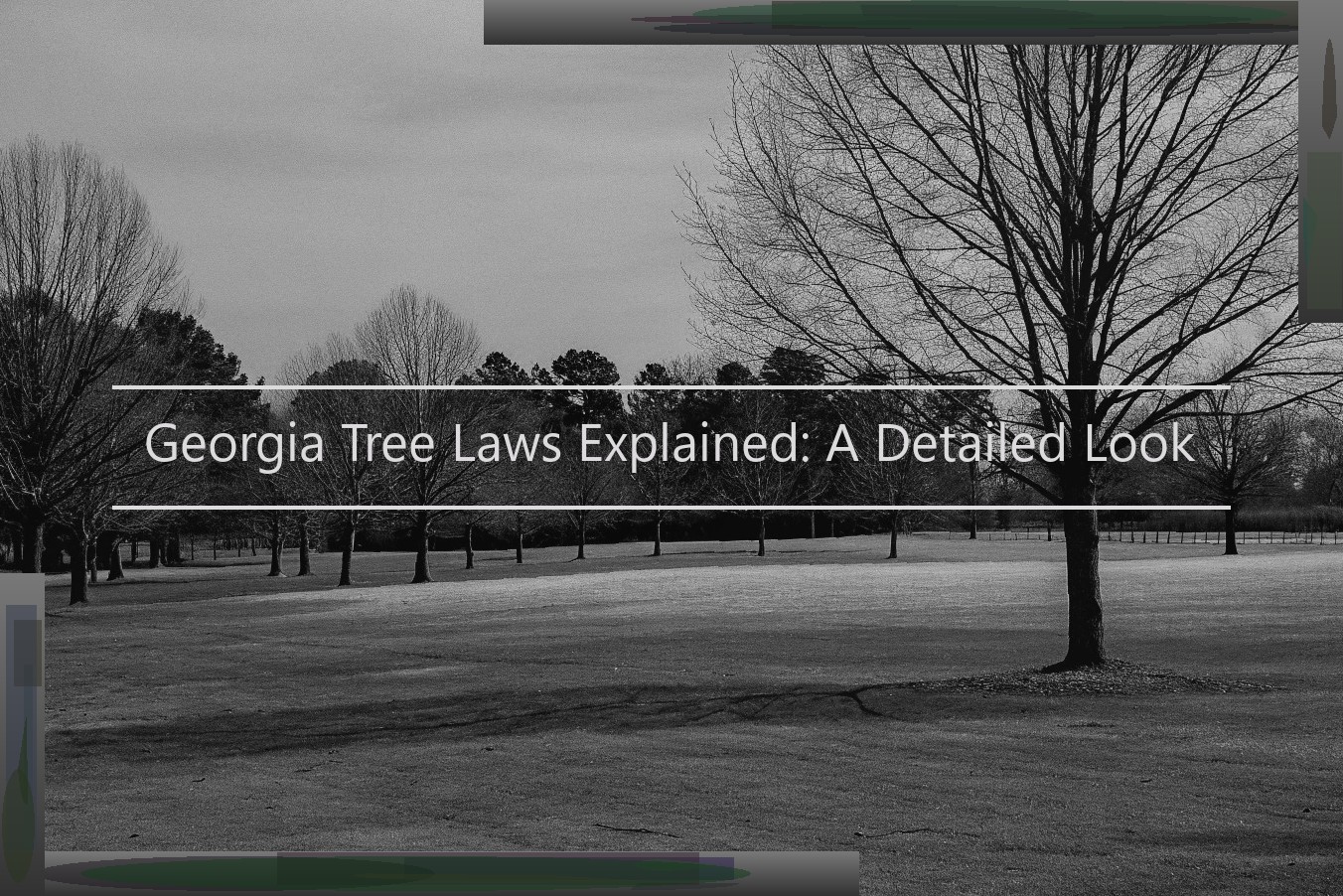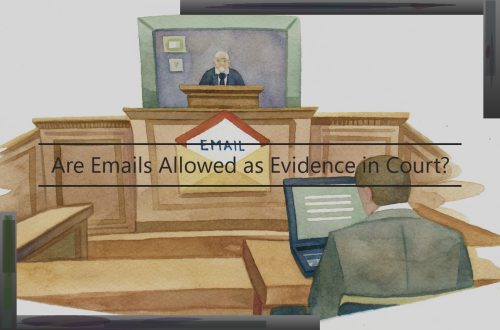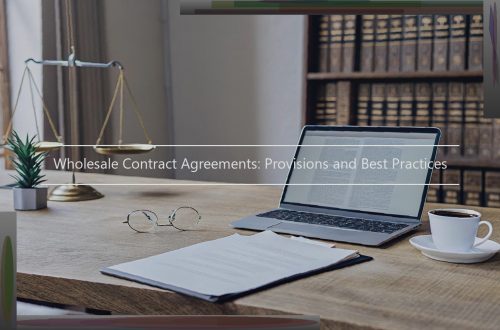Georgia Tree Laws Explained: A Detailed Look
Georgia Tree Laws Overview
Georgia’s tree laws are a complex web of rules and guidelines aimed at the preservation of the state’s natural resources, public health, and private rights. Trees have long been considered valuable assets that require protection against untimely removal, providing shade, erosion control, and aesthetic appeal to the landscape.
The general framework of Georgia’s tree laws can be broadly divided into local ordinances, property deed restrictions, and statutory law. Local ordinances set forth guidelines for private land development that may restrict tree removal through tree preservation or tree replacement requirements . Property deed restrictions may be used by developers or homeowners associations to protect trees on private property and may not be restricted to tree removal by the property owner alone. Additionally, these restrictions may prohibit the construction of any structure near protected trees and impose fines for tree removal violations. By contrast, statutory law generally applies to tree removal on public lands and lands adjacent to active power lines. In light of existing economic, environmental, and quality of life factors that impact land development, the common thread among all of Georgia’s tree protection laws is their ability to balance individual property rights with environmental protection and preservation of the state’s natural resources.

Tree Removal Laws
In addition to the shrubbery guidelines, all of Georgia’s cities, counties, and municipalities also have specific laws regarding tree removal. It often comes as a surprise to homeowners that some municipalities require owners to obtain a tree removal permit before removing trees that are on their property. A good place to start is your local government’s website.
The property owner or a designated agent acting on behalf of the owner must submit an application to remove a protected tree in order to obtain a tree removal permit. The agent must provide legal authorization to represent the property owner at the time of application. Local laws may also require a site plan designating the location, species, trunk size, and condition of all trees proposed for removal.
A tree removal permit will not be required if a diseased tree is wholly on the owner’s property and poses an imminent hazard. Similarly, no permit is necessary when the tree is growing on an easement dedicated to transmission of sewer, water, electric, cable, or other utility lines if the tree’s health is being affected or the tree is interfering with the maintenance of utility service. There are also some local exceptions allowing the removal of certain trees in clusters to maintain vegetation clearance from homes. For example, Gwinnett County allows the removal of up to 4 native hardwood hardwood trees in each clustering area. Penalties for violations are steep; removal of additional trees requires a $1000 permit.
Protected Species of Trees
When most people think of trees in a residential area they barely think of them or even notice their existence, but if you are in the wrong place at the wrong time and run into the wrong type of law enforcement personnel you could face a fine for having trimmed that oak tree in your yard that you didn’t even realize was covered by local ordinance. The truth is Georgia has a number of laws that relate to protected trees and many municipalities have additional ordinances that cover other species of trees not protected by state law. In addition, Metro Atlanta is home to many areas that are governed by HOAs and HOA rules may extend the protections beyond what state law requires. This article will explore the various species of trees that are protected by state law.
Georgia Law protects the following:
Oak (Quercus) in general
Pecan (Carya illinoinensis)
Sugarberry (Celtis laevigata)
Southern red oak (Quercus falcata)
Southern black oak (Quercus velutina)
Willow oak (Quercus phellos)
Scarlet oak (Quercus coccinea)
Pin oak (Quercus palustris)
Flame oak (Quercus citriodora)
Black cherry (Prunus serotina)
American Beech (Fagus grandifolia)
Yew (Taxus sp.)
Dawn Redwood (Metasequoia glyptostroboides)
Eastern Hemlock (Tsuga canadensis)
Pine (Pinus) in general
Southern Longleaf Pine (Pinus palustris)
Paper Bark (Melaleuca quinquenervia)
Eastern cottonwood (Populus deltoides)
Pond cypress (Taxodium distichum)
Eucalyptus (Eucalyptus spp.)
Chinese elm (Ulmus parvifolia)
Mesquite (Prosopis spp.)
Saltcedar (Tamarix spp.)
Tamerisk (Tamarix spp.)
Tamarix (Tamaric spp.)
Mimosa (Albizzia julibrissin)
Norway maple (Acer platanoides)
Himalayan cedar (Cedrus deodara)
Kahili mallow (Hibiscus tiliaceus)
Blue gum (Eucalyptus globulus)
Myoporum (Myoporum spp.)
Ficus (Ficus spp.)
Copper-leaf (Bauhinia spp.)
Camphor (Cinnamomum camphora)
Melaleuca (Melaleuca spp.)
Balloon vine (Cardiospermum halicacabum)
Chinese parasol tree (Firmiana simplex)
Guava (Psidium guajava)
Kitaibel’s globe mallow (Sphaeralcea kitaibelii)
Tamarind (Tamarindus indica)
Pawpaw (Asimina triloba)
Japanese privet (Ligustrum japonicum)
Golden rain tree (Koelreuteria paniculata)
Chinaberry (Melia azedarach)
Chinese tallow (Triadica sebifera)
Crimson bottlebrush (Callistemon citrinus)
Carrotwood (Cupaniopsis anacardioides)
Albizia (Albizia spp.)
Sweetgum (Liquidambar styraciflua)
Ginkgo (Ginkgo biloba)
Crape myrtle (Lagerstroemia indica)
Siberian elm (Ulmus pumila)
Tree-of-heaven (Ailanthus altissima)
Black locust (Robinia pseudo-acacia)
Boxelder (Acer negundo)
Elm (Ulmus spp. [except disease-, insect-, or pest-damaged trees])
Winged elm (Ulmus alata)
Hackberry (Celtis occidentalis)
Ash (Fraxinus pennsylvanica)
Mulberry (Morus spp.)
Olive (Olea europaea)
Boogie-woogie (Plantago lanceolata)
Yellow buckeye (Aesculus flava)
Hornbeam (Ostrya virginiana)
American elm (Ulmus americana)
Pineapple guava (Feijoa spp.)
Himalayan pine (Pinus roxburghii)
Plum (Prunus spp.)
Dahoon (Ilex cassine)
Cherry (Prunus spp.)
Cottonwood (Populus spp.)
Radiata pine (Pinus radiata)
Elm (Ulmus spp. [except disease-, insect-, or pest-damaged trees]).
More of a concern should be whether your municipality has additional ordinances that apply to trees that fall outside the scope of the above list. For example, in unincorporated Cobb County (meaning it is not covered by any city’s ordinances) trees are classified and protected according to the circumference of the tree trunk. Simply stated, a tree with a trunk with a circumference of 8.5 inches measured at a height of 4.5 feet is regulated under municipal law. Many cities in Georgia have similar ordinances, some more detailed than others. Additional restrictions may arise based on the type of area, urban, suburban, rural, black soils, or red clay, etc. Some of the ordinances may be as vague as a tree being protected merely by the fact that it smells bad and up to a hundred feet away it is still unpleasant to be around or caress its bark only to get a nasty rash.
In Metro Atlanta a number of trees are protected under state law and municipal ordinances such as Beech, Oak, Pecan, Eastern Red Cedar, Yew, Willow, Eastern Cottonwood, Blue Spruce Fir, American Juniper, Live Oak, Southern Red Oak, Whip-Poor-Will, Eastern Hemlock, Cedar, Cherry, Peach, Dogwood, Crabapple, Sweet Gum, Southern Shortleaf, Slash, Jack, Bermuda, Honey, Magnolia, Mulberry, Plains Cottonwood, Ash, Quaking Aspen, Eastern Cottonwood, Willow, River Birch, Ponderosa Pine and the Eastern Cottonwood. However, be aware that although some ordinances may only cover certain species, many ordinances extend protections to any tree that shares the characteristics of the protected trees which can drastically expand the number of trees that are protected.
Neighbor Disputes Regarding Trees
Under Georgia law, a landowner has the right to trim back branches and roots of a neighbor’s tree and shrub which have grown onto his or her property. Branches hanging over your property line can be lopped off, but one may not enter onto his neighbor’s land to affect the cutting of the branches. In other words, you can take matters into your own hands to trim the offending branches, but only over your side of the property line. The lopping and trimming should be done at the divider of the two properties or dropping some of the weight, such as cutting branches so they remain attached to the tree, may be considered trespass and destruction of property.
If branches or roots from a neighbor’s tree are encroaching upon your property, the offending party has a right to remove the encroaching tree and root material at his or her own expense. If an injured party seeks the judicial remedy of injunction, rather than self-help, the injured party will not be allowed to recover damages for the tree or shrub which is trimmed. If the tree was diseased and the damage was unknown to the neighbor who trimmed it, that neighbor, however, will be able to recover the full value of the tree. Goodman v. McNabb, 158 Ga. App. 38, 279 S.E.2d 299 (1981); Bandy v. Central Georgia Power Company, 125 Ga. App. 870, 188 S.E.2d 911 (1972). The general rule in Georgia is that a land owner may enter and cut away any roots or branches of a neighbor’s tree so far as they may overhang or encroach upon his yard, and if he exceeds this right and commits waste by killing the tree or any part of it, he may be liable. Whitaker v. Bird, 191 Ga. App. 578, 382 S.E.2d 195 (1989).
In the event that the encroaching branch or root causes damage to the neighbor’s property, the party suffering the loss may recover common law damages to compensate the owner for cost of the lost use of the property during the period the owner was deprived of its use. Norrus v. Hall, 77 Ga. App. 748, 50 S.E.2d 860 (1948). Furthermore, any neighboring land owner or tenant may cut off branches and roots actually entering his property, or that will pass to it when ripe. O.C.G.A. § 51-9-31. Under Georgia’s common law, however, a neighboring land owner has no duty to prevent the branches of his trees growing over on his neighbors from hanging low enough so as to interfere with his neighbor’s property. At one time, a tree owner had a duty to prevent any branches or roots from encroaching on the adjoining lot. Atlanta Lumber Co. v. Ga. R. Co., 73 Ga. 208 (1884). This rule that requires a tree owner to prevent the encroachment of his or her tree has been greatly relaxed in more recent decisions. As a result, if a tree falls on the neighboring land and causes damage, the owner of that tree is not liable for damages unless the neighbor can prove that the tree was diseased or was in some condition which would make it reasonably probable to have fallen. King v. Ft. Valley R. Co., 133 Ga. 57, 65 S.E. 511 (1909); Bell v. Macon Motor Car Co., 205 Ga. 855, 55 S.E.2d 180 (1949).
In Georgia, an owner of residential property who plants trees or shrubs must exercise reasonable and ordinary care to maintain them and a failure to do so may result in liability for the resulting damage to a neighboring property. Wardlaw v. Liberty Bell Agency, Inc., 115 Ga.App. 572, 155 S.E.2d 491 (1967) (decided under prior law imposing liability on "caretakers" of trees). In that case, the jury was authorized to find that felled branches and limbs caused by a high wind were not the result of negligence because the circumstances of the case did not indicate that the owner of the shrub was negligent in failing to trim it. Wardlaw v. Liberty Bell Agency, Inc., 155 S.E.2d at 493.
Tree Protection and Development
Many Georgia cities have begun to recognize the benefits of trees within their communities through the enactment of ordinances aimed at tree conservation. With these ordinances, cities have created a framework to regulate the conservation of trees along roadways, if sufficient natural vegetation exists along the right-of-way; along tree save areas; and in areas that are part of any construction development project. Tree save areas may include natural features such as streams, rivers, creeks, ponds and wetlands. In addition to protecting trees, these ordinances may also conserve shrubs and other natural vegetation . Any tree save areas will be designated on applicable city-approved site plans, and may be marked in the field with environmentally sensitive construction areas flags. In some cases, property owners who are developing property are able to reduce expensive clearing and grading costs by complying with city ordinance requirements and conserving specific trees. Finally, if a developer is unable to fully comply with any city ordinances, then it may ultimately be required to pay a fee to a city for having to address tree replacement and/or tree planting at any later date.
Tree Laws for Homeowners
How Georgia’s Tree Laws Affect Private Homeowners
When it comes to trees and shrubs that branch over onto neighboring private property, homeowners and their insurance policies tend to be caught in the middle between aesthetics and reality. Tree laws in Georgia can make it difficult for the average homeowner to understand their responsibilities and their rights, and many property owners have unwittingly allowed some trees or shrubbery to remain or cut down trees that were not theirs to cut down in the first place.
Although there’s no one-size-fits-all rule that applies to tree laws in Georgia, there are generally two rules that concern most homeowners. The first rule states that the property owner is responsible for maintaining the part of the tree or shrubbery that sticks out onto their property. Fortunately, in many cases, that property owner can get a reasonable amount of notice before they have to do anything. For example, if your neighbor’s branches begin to hang low over your yard, you may have to notify your neighbor in writing before you can take down or trim the offending branches without repercussions. In this situation, the law requires notice, but doesn’t address who is responsible after the fact.
The second rule states that the original owner of a tree is responsible for any damage caused by that tree or its roots. If your neighbor’s roots creep under your yard and lift up one of your driveway slabs, for example, that neighbor is responsible for the cost of any repairs you may need. This is true even if the tree is dead. The law does not require notice in these situations, and the law doesn’t differentiate between new and established trees.
It may sound great in theory, but in practice, tree laws in Georgia can be a little fuzzy. Most homeowners have not taken the time to understand their rights when it comes to trees on their neighbor’s property. Even when homeowners want a tree on their neighbor’s property removed, they often do not know how to legally have that tree removed.
Complications arise out of the lack of clarity over the timing of evaluation. As stated above, the timeframe for taking action regarding branches encroaching on your property is left open to interpretation by lawyers and judges, which can lead to disagreements amongst property owners. For example, tree limbs that are merely hanging over a property may require notice, but if they should fall due to bad weather and injure someone, the property owner should theoretically no longer be required to notify the neighbor. However, that does not mean that they will not make some type of claim against the neighbor for the damages he or she suffered.
Many homeowners mistakenly believe they can take down their neighbor’s trees if those trees are dying or have already died. Unfortunately for those homeowners, simply having a dying tree in your yard does not give you the right to survey any neighboring yards for trees that may be encroaching upon your yard. Although Georgia statute does not require notice be given to the neighbor, the law does require the homeowner to prove that the encroaching tree is damaging their property. The law looks at damages not merely as an invasion of the property line, but as actual damage to the property itself.
The possibility of possible recourse is only half the issue when it comes to trees and homeowner’s insurance policies. It is also important to homeowners to recognize their own responsibilities with respect to their own property owners’ insurance. For example, your insurance policy may cover damage to an encroaching tree’s branches if they are damaged by a storm. However, if you decide for yourself that the branches should be cut, your insurance may not cover the loss if the branches happen to fall on your neighbor’s car.
Before deciding to take down your neighbor’s tree, send them a letter notifying them that their tree has encroached upon your property and let them know you would like the tree to come down. Trees in Georgia grow quickly, so you may need to update your letter every six months until the issue is resolved. If you plan to take down the tree yourself once the issue is resolved by your neighbor, it is wise to include that information in the letter as well.
If the problem continues after you give proper notice and your neighbor still does not comply with your request, it is time to Call a Lawyer. Many tree disputes around Georgia turn into legal matters, and it sends a powerful message to your neighbor that you mean business. The law entitles you to compensation, so it is worth understanding your rights before making a move.
Enforcement Resources and Legal Action
Violations of property line boundary tree laws, no matter which law applies, can often be difficult to detect. It should go without saying that if two neighbors are on amicable terms, they are not going to lodge shared complaints with their local code enforcement officer regarding overhanging branches. Even if a municipality has tree protection ordinances, the commission or board responsible for enforcing it will likely only consider an illegal cut-down tree a priority if the property owner submits a formal complaint. In Georgia, private citizens have no recourse against offenders unless the action affects their property.
Georgia courts recognize private rights of action for negligence and trespass as the most common means of redressing trees that have been deliberately harmed by a neighbor. Although both torts yield damages to compensate the injured party for losses incurred, their scope and application differ. While negligence addresses harms that are reasonably foreseeable, trespass addresses physical invasions of property regardless of whether or not the harm was foreseeable. For overhanging roots or branches, trespass is most appropriate. However, if the nuisance interferes with the use and enjoyment of property, negligence might not be a proper theory. A landowner is generally not liable for all harms to other property caused by the growth of trees, but may be liable for losses that are reasonable foreseeable. For example, if a tree’s limbs or roots damage water or sewer lines, then a nuisance would likely be created that is a foreseeable consequence of the negligent maintenance of the tree. A nuisance claim can also be used in circumstances where a tree’s presence on a property can reasonably be construed as ambush for trespassing animals that have been harmed by the trees.
Recent Developments and Trends
A handful of recent cases have highlighted the ever-changing landscape of Georgia tree law. In 2019, a Fulton County judge ruled in McGill v. Goodall, No. 18EV002790, 2019 WL 8401603, slip op. at 1 (Fulton Cty. Super. Ct. Sept. 30, 2019) (not officially reported), that homeowners could not disclaim liability for damage to trees by contract, and a Fulton County jury held that the value of a live oak tree damaged during construction exceeded the cost of replacing the tree.
The Georgia legislature has also weighed in to address tree conflicts. The 2019-2020 Georgia General Assembly session resulted in the passage of SB 121, which amended OCGA 44-14-60 to provide a mechanism for landowners to secure relief for trees damaged by underground coal mining. In 2000, the Georgia Legislature created a cause of action for the canopies of trees, shrubs, and bushes to be cleared in order to extract minerals from or alter the surface of land. OCGA § 43-14-60(a)(5). After underground coal mining operations damaged a number of trees on land not directly above the coal seams , the Georgia Surface Mining Act was amended to allow claimants to file an application on their own behalf requesting relief for trees damaged by underground coal mining. OCGA §§ 43-14-61 and 62. Ministerial functions in response to such applications are prescribed in OCGA § 43-14-63.
As to the future, legislators and policymakers continue to look at ways to encourage property owners to fully protect their trees while respecting the legitimate rights of neighbors. Already, model tree ordinances have been proposed to help local governments adopt or amend their individual policies. As public awareness of issues affecting trees and ordinances regulating their removal continues to increase, policymakers will be searching for models and solutions that result in balanced laws and policies that protect trees while encouraging responsible development.



